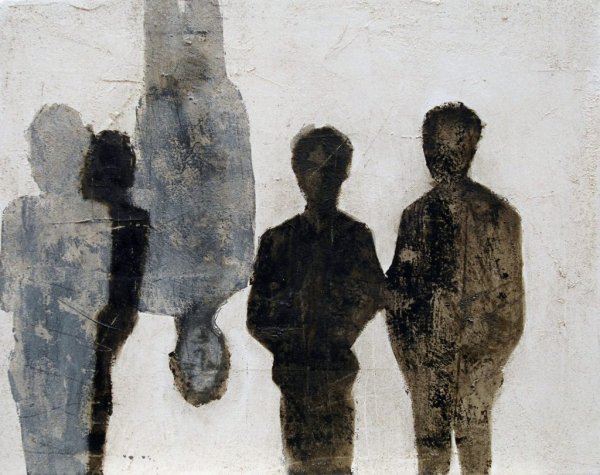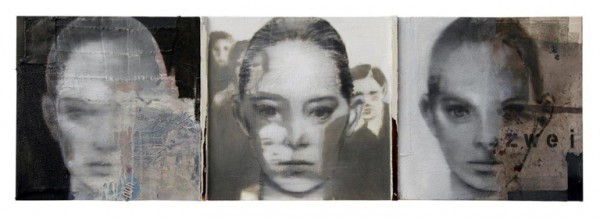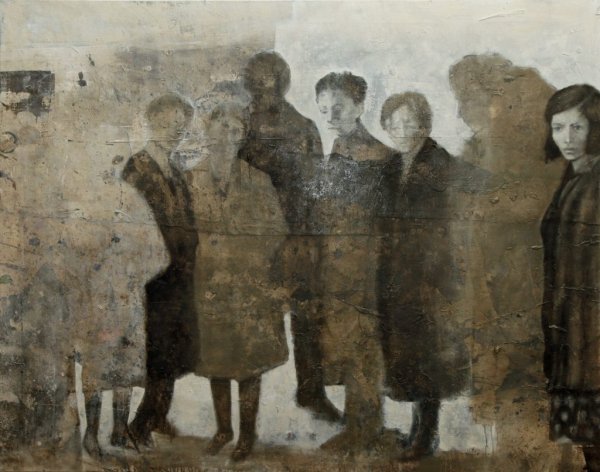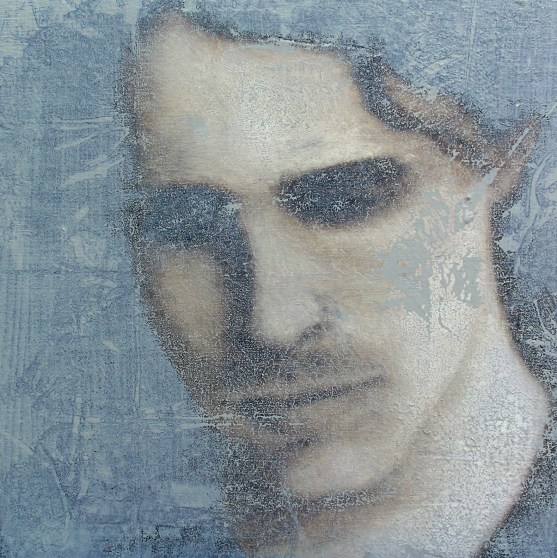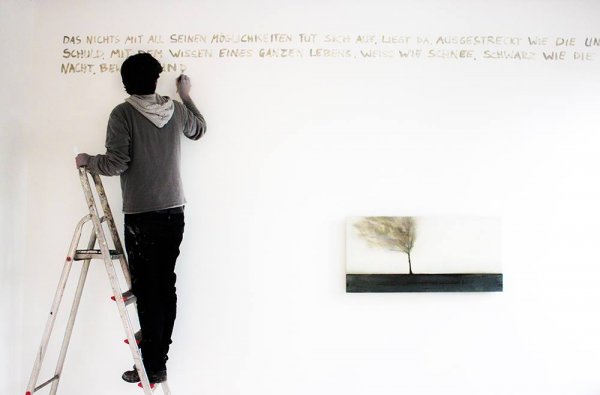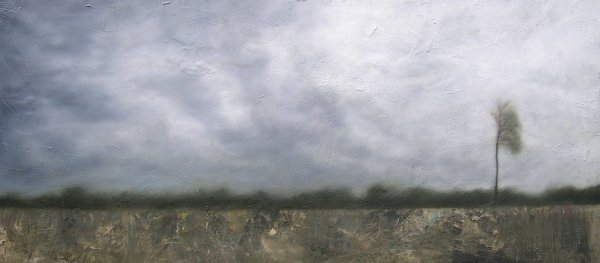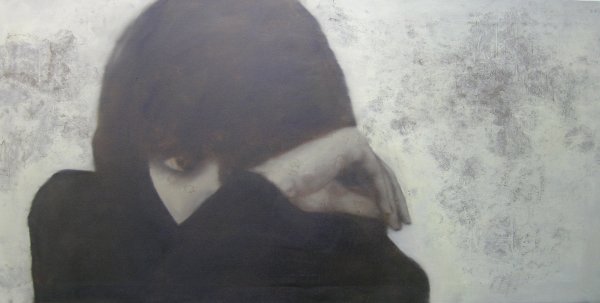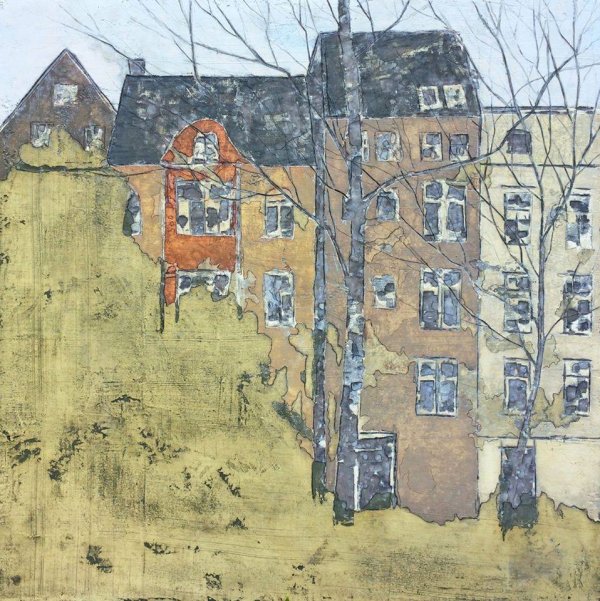Kai Savelsberg is a complex visual artist and also a poet, writer and theatre painter. His artworks have been exhibited in important European and American galleries.
"Art is (perhaps) the sum of all thoughts that one has made and has not (yet) made", states him. "From a post-factual point of view, art is the banal answer to a hyper-reality that only remains silent in order to express the sigh of one's own incredibleness. Satirists rub the astonished edges of their eyes at the factual satire into which their pairs of eyes stare and refuse to exaggerate the undercutting of simple thinking. Art should be less noisy and louder, more concentrated, less sedately, but thought leisurely, well done, certainly, here and there, seen and forgotten time and again".
The haunting charm of a world falling apart or overturning, of clogged roads leading to the wall, of cities eaten by nothing as it used to happen in "The endless story" of Michael Ende, the discreet lyricism of disappointment or wandering, the mists in which things sink and lose their identity or their meaning, the obsessive refrains of loss, the impulses of nostalgia that penetrate even through the memories from which the impressions of coloratura have been erased, which are to be found in the works of Kai Savelsberg, are subjugated by an invincible lust for life. What permeates these works in which colours and shapes fade and intertwine is a reverberation of beauty that is stronger than the morbid breath that touches and grinds everything.
Note: some reproductions of his works can be seen here: http://kai-savelsberg.de/.
Ilinca Bernea: Tell me, Kai, were you born in Aachen?
Kai Savelsberg: Yes. I stayed in my home city all of my life, but I like travelling and having exhibitions in other countries. When I had my training in theatre painting, I had two colleagues that came from Romania. They told me a lot of things about your country.
I.B.: Which exactly is your professional background?
K.S.: I made painting for theatre. I am not the stage designer, but the one who executes the projects. I am building everything that comes up.
I.B.: Your paintings give the impression that you keep trying to find new shapes for the same haunting something.
K.S.: I am trying not to get stuck on the same path, aesthetically speaking. But the feelings are, more or less, the same. Of course, we change in time and what we experience transforms a part of our views and approaches of life, but our main way of being on the inside is unchangeable. The artistic language is different from a period to another, either in what I paint or write, but I am essentially the same. Of course, the melancholy is there...
I.B.: The first word coming through my mind when I contemplate your works is Sehnsucht. You make an art of the absence, that mixes times and spaces, pieces of memory with fictions and distant calls and turns them into longing. Your painting is about twilight feelings and experiences, about what can be foreseen in the moments of melancholy or in the transit state from being awake to sleep. Your art is a meditation on the time's impact over the soul's guide marks. Your paintings are parables about memory that suffers various transformations itself. The first impression of lived moments is reproduced by the memory in a more vivid way in the next future, then the mind remembers a copy of them, than a copy of a copy... It keeps recycling and processing and rewinding the primary experience and eventually, what the soul retains are sometimes only some vague suggestions, some shadows or ashes of what has lived once. As the vital substance gets lost from the memory, the mind tries to recover the lost with its one means, but it's a failed act. Your paintings depict the life's discrete fading, the beauty of the vanishing world.
K.S.: That reads well. There are many people bringing up the description of melancholy about my works, but my intention is not to paint the melancholy, it just comes along with the expressive means employed by the chosen theme. It's not a goal, but I go with the flow and, eventually, I get there... In most cases I start with a really colourful background and at the end the colours simply vanish. The disappearance of life, the transience of a moment, the fleeting, unspoken and certainly also the longing for "measurable" life before it goes away, I try to translate all of this into a visual language. This visual language always includes the question of how much information a picture needs, how much beauty to be heard, seen and felt.
I.B.: You are not quite the elaborated type of artist?
K.S.: When I start, there is not a certain plan actually. I try to find something... a specific connection with a face or a character or an image. I try to picture how they might be in reality, to figure out their life and to shape the part of the story which is meaningful to me. It has to be touching to me too... Otherwise I wouldn't find any reason to make it visible to others.
I.B.: What inspires you? Who are your models?
K.S.: When I am doing a portrait, it might be of someone I know but, in the end, I try to create a unique character which is not intended to be a reproduction of a known pal. Could be a stranger to me as well. It's more interesting to me to create a human shape that I cease to associate with someone known. Eventually, this "another" could carry on my own feelings better than the initial model. The person who happens to be my acquaintance cannot talk for me so well.
I.B.: So, you are transforming your neighbour fellows into yourself? (laughs).
K.S.: In a way... yes.
I.B.: You prefer to be less related to the model though?
K.S.: For me is always better to improvise and to let my imagination flow. I'm trying to be as open as possible. There are some nice coincidences showing up when I come to "guess" the story of someone unknown that is posing for me.
I.B.: If you come across a new figure or if you see one in a photography, does it happen to you to have the feeling that you could guess his biography or character?
K.S.: Yes. At the beginning of last year, I made a group of portraits, of course non existing persons, and I wrote a fictional text about each one of them. I wondered: is this a hard person or a soft person? Would I like him or her? to get the complete view. There were some that I wouldn't have enjoyed meeting and others that were so nice and beautiful that I would have fallen in love with. I need to feed my imagination while painting, to surprise myself too somehow.
I.B.: I can see.
K.S.: You can make the portrait of a certain someone that could be recognized, but this is not what I am searching. Only what sets my fiction in motion is meaningful to me. If you just sit somewhere and see people passing by or in a train and you let your mind imagine their life, you may be completely wrong, but it's still funny to do it.
I.B.: Have you discovered something surprising about yourself too while painting or writing? Let's say a hidden side of yours?
K.S.: Of course. I think that's one of the main reasons why artists are creating. It's dangerous in a way because you may find something that you dislike or that you are not ready to confront. Every time when you write or paint you are stuck at the same point because you arrive to the border of your own personality. And you realize you cannot go further and that's not nice at all.
I.B.: Have you ever had to deal with the dark side of yourself during the creative process?
K.S.: Maybe I have a preset limit. There is a point where I stop and I don't push the exploration any further. An exhibition is something very private actually that you expose publicly. People can see through you... You become transparent. I am opening myself in a way that most people who look at the paintings or read the texts are foreign to. They come to the gallery to consume culture. Many of them. The attention they pay to the art works is sometimes a brief scan. They don't give the same as the artist is giving. Probably, it would be impossible, anyway. But I am always saying to my public: "if you are not willing to give anything from yourself, to get involved or to actively participate to the encounter with my art, then what I am doing is meaningless". If you don't give something of yourself you cannot taste, enjoy or feel what is depicted, an inner connection is needed. The art relies on this mutual involvement of artist and his audience. It's a communication, a conversation act.
I.B.: Art is certainly more than a simple delectation of the senses for the audience. I think it has to be a little bit disturbing.
K.S.: I think that most people have lost a bit their means of connecting to art, they are prone to approach it in a consumerist manner. So, they go to shop and buy, they go on internet and consume stuff and they came to internalize this attitude and to reproduce it in all circumstances. But if one goes to the theatre or in an exhibition hall, he has to be ready for a dialogue, not for a simple achievement. Giving something of himself is a must for enjoying the experience and for perceiving it as valuable. One cannot ever know the value of an art piece without embarking in a sensible relationship with it.
I.B.: It has been stated that true art is neither something useful nor something limited, with certain borders. It is and it is not an object. More specifically its object is mutating and expanding in several dimensions, it exists as a palpable reality but also in the mind of the artists and of each one from the audience. Furthermore. The urges of the quotidian life disrupt us from our deeper self and sometimes art is re-establishing the connection. It put us in contact with the deeper layers of existence, while the entertainment tries, by the contrary, to pull us out of ourselves, to keep us at the surface, disconnected, in a comfortable state. Art is meant to discomfort us. Isn't it? Consumerist society is inviting us to get rid of our deeper layers of feeling, to float on the surface, to be someone else, to play a role, to wear a mask, while the art is creating a bridge that brings back to our inner lands. It had the role to deliver our true self back to us. The quotidian life doesn't provide us enough occasions for introspection, enough resources of beauty and meaning, but the art offers plenty of questions, insights and emotional backups.
K.S.: I totally agree.
I.B.: As you pointed out in your statements and observations, there is something annoyingly superficial within the consumerist societies. The commerciality invaded our lives. People take the virtual matrix for reality... they are confused and disturbed. Besides, the new-media suggested people to invest more in their image than in their actual existence. Eventually we are the ones consumed by fake realities.
K.S.: Very often, yes, life is not real enough.
I.B.: What I saw in your paintings is a regret of not believing in salvation or in a spiritual surreal dimension. You don't try to find meaning beyond reality, but in the very core of it. Your works try to capture a strong essence of the fact of being alive. You are weeping the vanishing world, the fact that everything fades away.
K.S.: You got it right. Actually, it's like... being an optimistic person, but very aware of the bitter side of existence and of the fact that everything is going to come to an end. It's not good to think about it all the time, but in the moment when you have an intense experience and a great feeling, it could happen to think: yes, but it will be lost. I can't really hold it. These beautiful things that you cannot keep deserve to be caught in art. I can clearly see what went or is going wrong. But I'm still full of passion. My paintings gather all these thoughts and states in the same picture. People like me and like you try to live anyway... in spite of the conscience of loss.
I.B.: In my view, true art is not about selling stories and fantasies about what could be above reality or beyond or about trying to comfort people giving them hope or excitement or to help them to make peace with death, pain and solitude. No. It is about making them aware of the beauty of living and of the depth of some experiences. Art is rather nihilist, but in a very vital way. It doesn't provide for answers or interpretations: these are like anaesthetics. To make a word game: art related to aesthetics.
K.S.: (laughs).
I.B.: Tell me about how you relate with the given frame of contemporary art movement?
K.S.: I try to avoid relating to others or letting myself inspired by what they do. Most critics are prone to label anyone and to put in a box his creations. They try to catch me too, you know. I've had an exhibition in Washington and they told me that my art is German... they associated my works with the ones of artists from the 19th and 20th century. Then, I went to Guggenheim and I went to a section called the New German Gallery and I saw what they meant. Of course, there are real connections between my paintings and theirs and the ones of some contemporaries as well. Sometime I feel close to another artist and of course I admire many. But to me music is more important though, it has a stronger impact upon me. Of course, I have relations in the art's world, I also have friends working in theatre... But my inspiration comes mainly from life and music or some movies. There are some classical figures, surely, that I much appreciate and I find impressive. To tell you the truth, I don't like artists that much. They are a little bit too impetuous for my taste. Most of them claim a certain superiority from the kind: "I am the one who knows everything" and it's obviously not true. There are people with a completely different background that can have a deep understanding of life. Truthful people can be anyway and do anything. And talking so "big" about yourself or playing the all knowing, over and over again, is rather "small talk". When someone who is not initiated in art comes in my atelier, I like to ask him what he sees in my paintings and sometimes he comes up with something more meaningful and "real" and plausible than most art critics or creators. They have a more genuine approach of a work and they discover in it more relevant things.
I.B.: I would like to mention here that there is a certain degree of conformism, normativity and, accordingly, snobbishness in the academic world. Throughout the history of arts, the academics were always prone to put some pressure on the creative freedoms and languages. They kept trying to instil some canons of shape and taste. They were in power so... But the true artists always fought this pressure. It's an eternal conflict. Let's think only of "Der Blaue Reiter"...
K.S.: There were so many really good artists that failed to be appreciated in their times or even later. That cliché: you have to die in order to be recognized is not always available. Upon me, what's important is to do what you feel compelled to, not to follow the demands of the market. But for many is more important to be "someone", to be acclaimed and get the prizes up. I am really bored of these conversations with my peers, they keep saying: "now I have this exhibition there, now I have this exhibition there"... I don't like the church, but the best conversations about art I had were with priests. I think it's because they are dealing with death and sufferance. For them that's not a topic associated simply with some representations, it is real. Some are also avoiding it, because it's morbid, but not them. They dare to see the death, to look at it with wide open eyes. I sold a work in an exhibition in Stockholm once, called "the last sleep" which was, actually, the obvious image of a dead female character and, the woman that bought it, once she has brought the painting at home, asked me: "what is the work about? I hope the one in the painting is not dead... I don't want to have the image of a corpse in the living room!" Then I replied: "Maybe she is sleeping, I don't know..." (laughs). Then I wrote a text about this conversation because I really loved the story. You always get what you see! Or you're seeing what you get, whatever... (laughs). If for the one who bought the painting the character is just sleeping, then she is sleeping.
I.B.: Tell me about your writing.
K.S.: Well... It's something I always did for myself. Then, once, I made an exhibition and I locked myself into the gallery for one week. I have built there a complete flat with a bed, a table, a chair... I made a film of myself while I prepared the food and I painted. I didn't have any mobile phone or radio or newspapers, not even a watch, so I didn't know what time it was. I wrote about paintings too. I wrote a lot. After a week my new paintings were hanging on the walls. I cut the film in the end and I kept only 45 minutes and I put the texts near by the works. At the evening, it was the opening of the exhibition, but I couldn't stand to be there, after one week of lockdown. It was too much for me... I just went on holiday and left the audience alone with what I did. It was, actually, the first time when I showed publicly what I wrote. It was very nice. The texts were not meant to explain what I painted, but to add them a new dimension, to complete them with another side of myself. The writing revealed another layer of feeling. Then I needed some more years to start doing speeches or readings. That's something really direct, more like the apparition on the stage, as an actor. I had the chance to communicate with my audience in a more open way. For me, this was a more interesting experience than just letting them alone with the paintings hanging on the wall. I am not writing on a daily basis, but I like to have some hours off, once in a while, and to put my thoughts on paper. Sometimes it's funny, some other times it's really not funny. I haven't learned that and it doesn't come easily. It took me some years get to the point when I felt ready to show my texts to others.
I.B.: In my view writing is a more personal affair, it is a bigger disclosure of our insides. Perhaps because we all associate whatever is visible and visual with the outside world. The writing is more introvert and makes us feel more exposed when presenting it to the public. Besides, the images have a higher degree of transfiguration and ambiguity.
K.S.: Yes, indeed.
I.B.: I will end this dialogue with few poems of yours. Thank you very much, Kai.
K.S.: Thank you too.
SCHMETTERDINGE
Ich liebe, also spinn ich.
VON IHR
Über meinem Bett hängt ein Bild von ihr.
Auf meinem Schreibtisch steht ein Bild von ihr.
In meinem Kopf kreist ein Bild von ihr.
In ihrem Kopf ist sie, nur sie.
Sie hat sich und ich hab sie.
KÖNNT SEIN
Könnt sein, ich weiß nicht was ich tu.
Könnt sein, ich hör mir gar nicht zu.
Mag sein, morgen weht ein andrer Wind,
Mag sein, ich bin vor lauter Neugier blind.
Und was soll ich jetzt wohl tun,
aus reiner Vorsicht plötzlich ruhen?
Und was wenn eine neue Welt erwacht,
hat das die Vorsicht auch bedacht?
Könnt sein, ich verlier dies gewagte Spiel,
könnt sein, das war vielleicht das Ziel.
Mag sein, alles war vertane Zeit,
mag sein, sie war noch nicht so weit.
Und was ändert das nach alledem,
wollt ich es neu oder nur bequem?
Und was wenn keiner mehr dafür brennt,
für das was man bis hierher noch nicht kennt?
Könnt sein, der Konjunktiv regiert die Welt,
könnt sein, dass er die Welt erhält.
Mag sein, ich hätt und könnt und sollt,
wohl besser nicht gekonnt oder gewollt,
aber was änderte das am Schluss,
wo alles ist und bleibt und muss?
STURMHOCH
Ruhe kehrt mit neuen Besen, meint
vor dem Sturm, schweigt lauter als zuvor.
Krieg wäre eine Übertreibung, beschriebe es
mit Getobe, das unablässig wütet.
Einhalt bot einst die Aussicht, hinab
ins Tal der Schlacht, geerdet war der Frust.
Es dreht sich ein Rad, hinauf
zur Gegenwehr, mit unbedingter Wucht.
Kraft sucht seine Energie, war
so reich wie Sand am Strand.
Ein einz'ger seiner Körner reichte, sodann
kehrte Ruhe ein, in meinem sturmhohen Land.
BUTTERFLY THINGS
I love, so I spin.
FROM YOU
A picture of her hangs over my bed.
There is a picture of her on my desk.
A picture of her circles in my head.
In her head she is only herself.
She has herself and I have her.
MAYBE
Could be, I don't know what I'm doing.
I might not be listening.
Maybe another wind will blow tomorrow
Maybe I'm blinded by curiosity.
And what should I do now
resting suddenly out of pure caution?
And what if a new world awakens
Would I care about it too?
I'm losing this daring game
maybe that was the goal.
Maybe everything was wasted time
maybe I wasn't ready yet.
And what changes that after all
do I want something new or just comfortable?
Could be the subjunctive rules of the world,
What I am trying to unveil
Maybe I had and I could and I should
probably not skillfully or willingly
But what turns to be that change in the end,
there where everything is and remains and must be?
STORMWAY
It's been said that before the storm that will sweep everything away, there will be a quieter silence than before.
War would be an exaggerated uprising,
Described with unceasing anger.
The look stopped suddenly,
Down in the valley of battle, the frustration was well-founded.
A wheel rises to return to battle,
with absolute force.
Power seeks its former energy,
huge as the sand on the beach.
One grain would be enough
To bring peace to my stormy country.
0 comentarii
Arhiva rubricii
Nici măcar nu îi mai conduci, ci le dictezi propria declarație a acelui moment!, Marius Constantinescu, un interviu cu Vadim RepinÎncerc să mențin mereu vie comunicarea, Marius Constantinescu, un interviu cu Hilary HahnCoabitarea în realitatea tehnologică - Speranța nu urcă niciodată cu liftul, Răzvan Rocaș, un interviu cu Toni NicaCa interpret de operă ai provocarea uriașă de a încerca să supraviețuiești în fiecare zi, Marius Constantinescu, un interviu cu Max Emanuel CencicHeartefact. Politică. Teatru. Fabulamundi. Playwriting Europe. New Voices., Anda Cadariu, un interviu cu Patrik LazićToate articolele din această rubricăRubricile categoriei
InterviuriLa persoana Ificti.on.allBibliopolisO săptămînă de prieteniAutismul, din interiorPrimul an de publicitateÎnsemnări mediavitaleJurnal de actor / actriţă în izolarePublicitate
